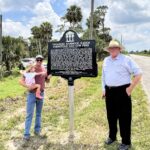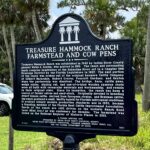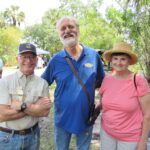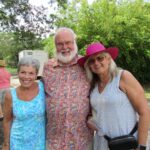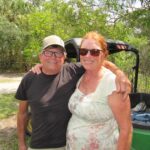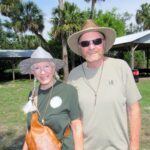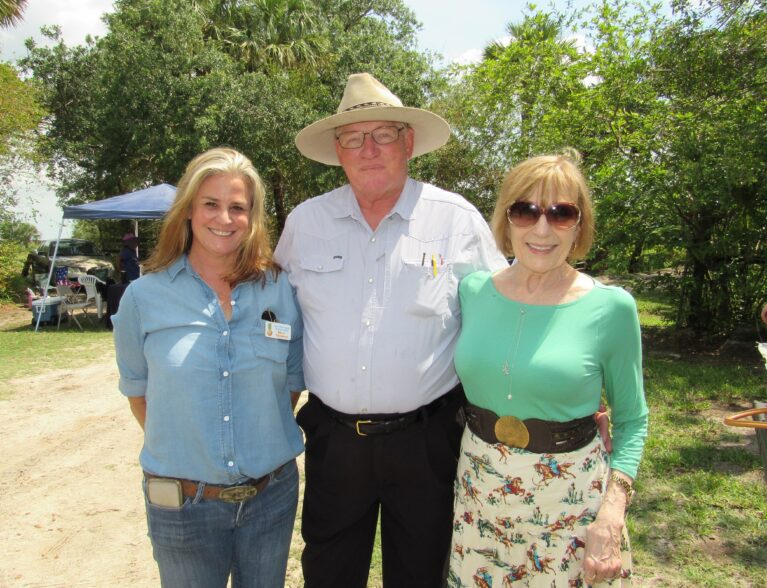
Vero Beach may be better known for its beaches and upscale gated communities, but there are still places west of town that harken back to Old Florida. When pioneer Waldo E. Sexton arrived here in 1913, he made his mark from the beachside to the western corners of the county. He established the Treasure Hammock Ranch in 1943 and it has remained operational under the loving care of his descendants.
Recognizing its historical significance, the Indian River Historical Society and the Sexton family recently received approval for a Historical Marker on the site, which was dedicated at a BBQ picnic on the 700-acre property.
Sean Sexton, grandson of Waldo and son of the late Ralph Sexton, commented on the difficulty of obtaining a listing on the National Register of Historical Places.
“You have to have a Ruth Stanbridge in your pocket,” said Sexton, referencing the county historian. “Let me tell you something, when Ruthie wants to do something, do everything you can to help her do it, because she wants good things for the world.”
Sean Sexton read a letter written by Waldo to the Federal Land Bank on March 9, 1943, requesting a loan to purchase roughly 640 acres of undeveloped land, calling it “one of the finest tracts of undeveloped land in the county,” and adding that he had an “opportunity to purchase the land under very favorable conditions, namely at $10 an acre.”
The additional pasture, he wrote, was needed to expand his dairy cows to meet the demand for milk at Vero’s Naval Air Base, and that he would pass the land on to sons Ralph and Randy, then ages 15 and 13, to carry on the tradition.
In a letter to Zora Neale Hurston, Waldo wrote, “I came from a place 8 miles from a dirt road in Indiana, called Buzzards Glory,” and said that after graduating from Purdue, he paid off his college obligations and had $500 left, which he used as downpayments on 120 acres of land, a business lot and 100 acres of oceanfront.
“The history goes on and on,” said Sean Sexton, referencing the fourth generation – his son Mike and wife Chandler MacWilliam Sexton (from another pioneer family), and the fifth generation, their daughter Emmy-Tate and son Ralph Mac.
“Because I had the kind of upbringing that my father had, we all developed this affection for our land,” said Sean Sexton, adding that even rarer than a beautiful piece of land is having people who care about it and would risk their lives for it.
“And my father was that kind of person. And in 2007, because I was raised by that kind of man who loved land and absolutely could not conceive of this land turning into rooftops, we enacted the first agricultural conservation easement in the state of Florida, according to the Rural and Family Lands Protection program. It was a historic thing,” he said, especially in light of Florida’s ever-burgeoning population.
In 1900, he said, there were 1 million cows and 1 million people in Florida. Today, there are still about 1 million cows, but 22 million people.
Before the unveiling, Sexton, who is Indian River County’s Poet Laureate, recited two of his poems, and read the words on the Treasure Hammock Ranch Farmstead and Cowpens Historic Marker, before Emmy Tate pulled the cord for the unveiling.
Highlights of the marker indicate that the bridge, barn, cattle pens, weigh scales, dipping vat and one-of-a-kind wooden squeeze chute were all built with vernacular materials and workmanship, and remain in their original state. Since its inception, the ranch has been a source of feeder calves and seed stock, and herds are still driven on the historic Ranch Road (now 82nd Avenue) as was customary for decades. The farmstead was listed on the National Register of Historic Places in 2013.
Photos by Mary Schenkel
- Kelly Thompson, Sean Sexton and Chris Sexton.
- Mike and Chandler Sexton holding Mac and Emmy Tate.
- Mike Sexton with Emmy Tate Sexton and Sean Sexton.
- Mike and Chandler Sexton holding Emmy Tate and Mac, Chris Sexton, and Sean and Sharon Sexton.
- Ruth Stanbridge with Grant and Jennifer Powell.
- Tony Young, Dan Kroger and Sharon Young.
- Barbara Secor, George Blythe and Toni Somma.
- Clyde and Jennifer (Sexton) Scent.
- Ann Sarver with Leroy Rodricks and Priyanka Rodricks.
- Mark Holt and County Commissioner Laura Moss.
- Pat Kroger and Jan Miller.
- Dana and Paul Brown.
- Dolly Thompson and Marybeth Gerbhardt.
- Gus Miller, Ann Holmes and Michael Gerbhardt.
- Sharon Sexton and Susan Williams.



